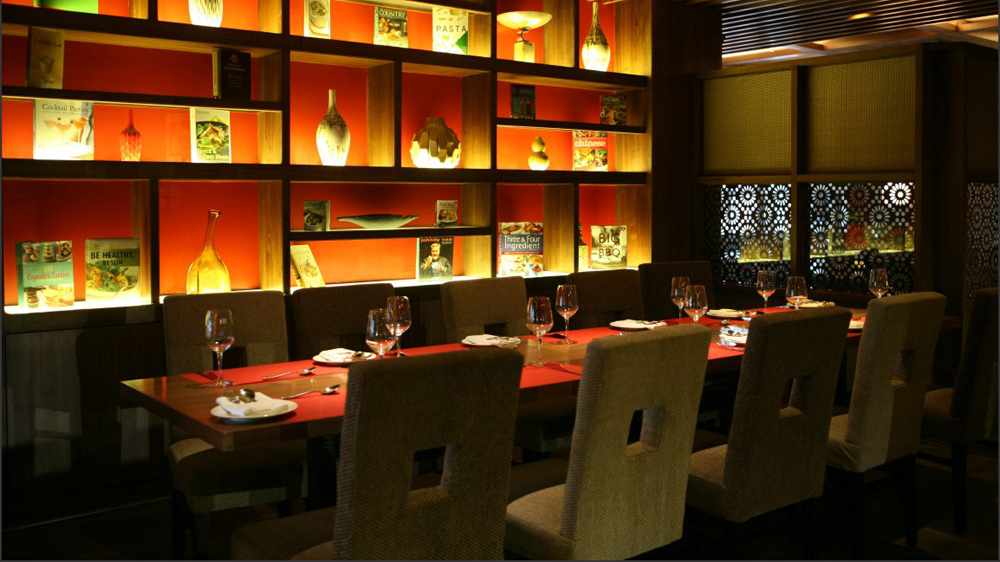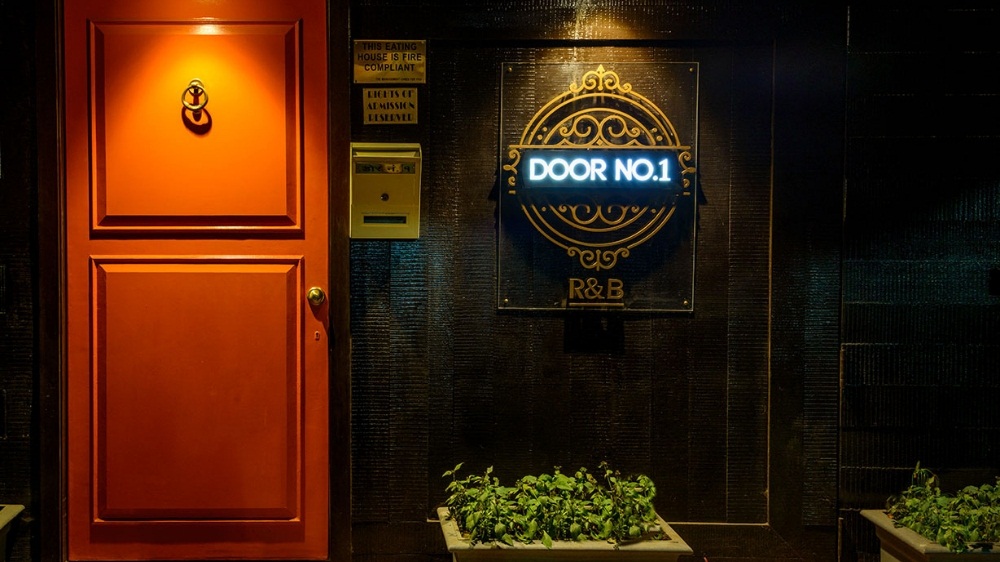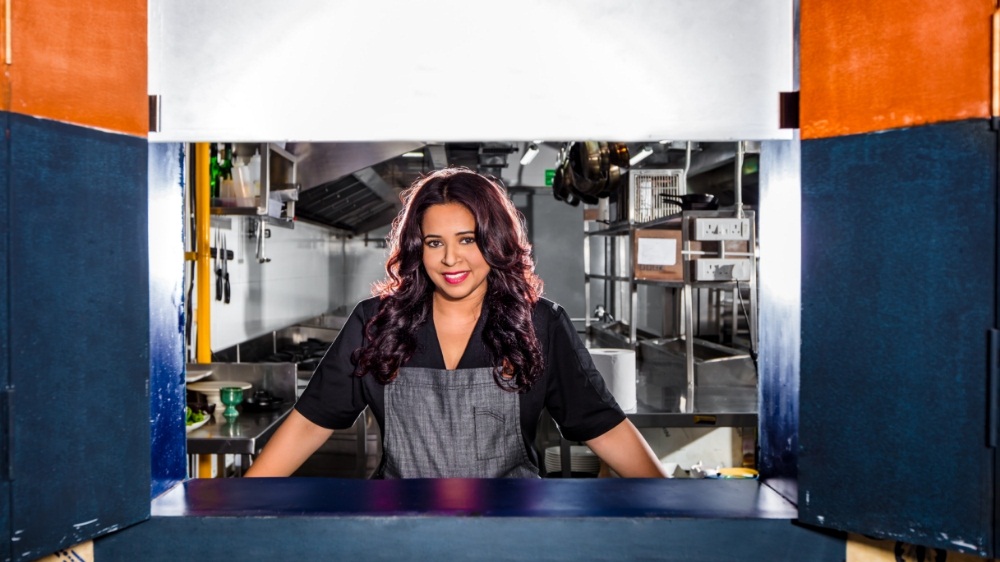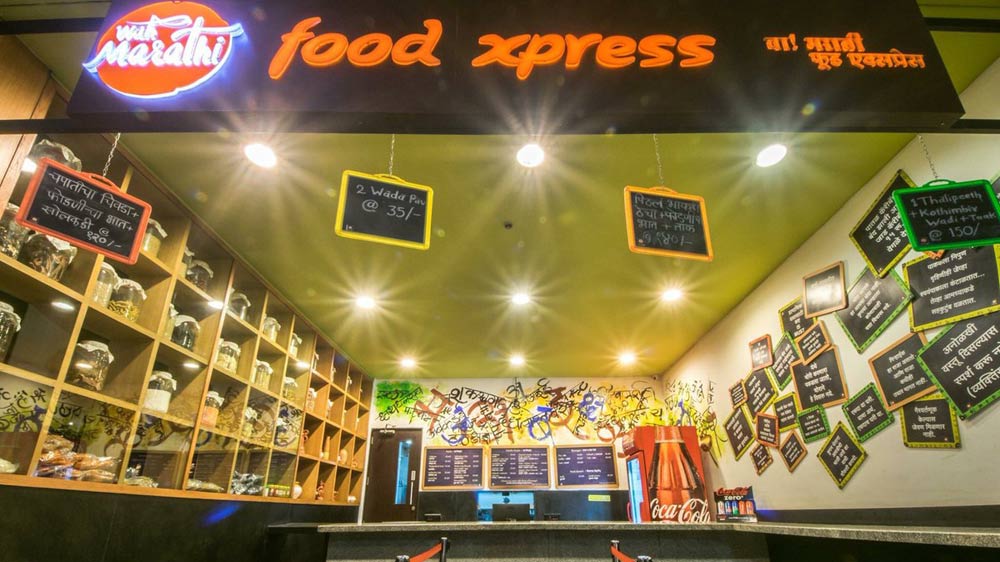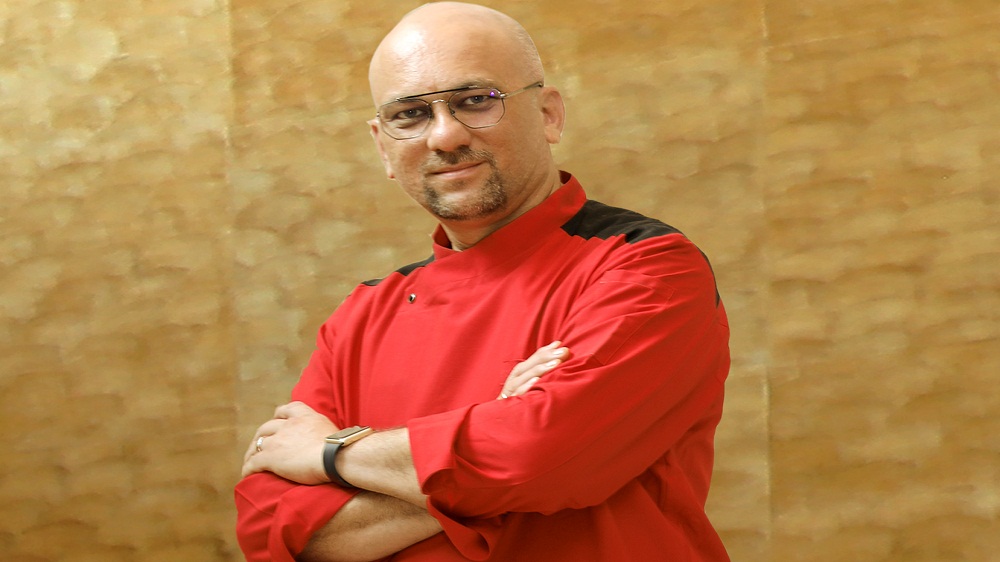
In an exclusive conversation with Restaurant India, Sandeep Jain, Owner, Eleven Course Restaurant shares insights about the idea of opening a fine dining restaurant.
After setting up a successful catering business, Sandeep Jain, who always dreamt of opening a restaurant serving only vegetarian food, incepted Eleven Course Restaurant at Netaji Subhash Place, giving an ode to his culinary expertise. Spread across 10000 sq. ft. with a bar, Eleven Course Restaurant is a modern fine dine restaurant serving international vegetarian fares.
When and how did you plan to open a restaurant?
As we already were into the catering business for more than two decades and as catering was not a throughout-the-year business, we wanted to launch a restaurant for making a brand and a regular business. It was in 2013 that we opened this restaurant.
How much time did you take to do background research for your restaurant?
It almost took us one year to make plans, work on operations, research and finally open our first restaurant. We belong to the vegetarian community and Pitampura is the hub for vegetarians, so we chose it over any other location. We also wanted to start from a region where people know us and hence we opened here.
How challenging was it to open a vegetarian restaurant?
We didn’t face any challenge on getting vegetarian clientele as we see these days top celebrities are going vegan. Also, coming from a community that is vegetarian, it was not a challenge for us. In India, basically in Delhi, all the big events that have vegetarian catering are done by us. And, hence, some of the top clients are from retail, real estate, jewellery and other such formats. We want to grow as a vegetarian-only brand.
What is your expansion plan going forward?
We are opening our next restaurant at Rajouri Garden in the next two months. Our target is opening around 10-15 restaurants in Delhi and then we may look at other markets. There are many locations we are planning to open restaurants at - GK1, Green Park, CP, Gurgaon and Noida.
What will be your focus taking your brand to other markets?
We will be focusing on fine dining. We may develop new concepts and new models, but that will focus on vegetarian food only. We can explore on South Indian or Marathi cuisine if there will be opportunity.
What are some of the marketing techniques you follow at Seven Course?
For the restaurant business if you are producing good food with good service, there is no campaigning required. No matter how much you have spent on your marketing, if food is tasty and service impeccable, it makes customers come back to you.
Tell us something about your menu?
Our guests experience culinary excellence at its best. Our menus reflect the fusion of Indian and continental dishes. A typical trait of our restaurant is our beautiful bar area that offers a calm ambience where you can enjoy a wide variety of wines, beers, classic drinks and trendy cocktails. Our aim is to provide unparalleled services in a fine-dining environment, combined with our traditional hospitality that sets our city apart. We are good at producing a new menu that celebrates the season’s reward, selecting grains, fruits, vegetables that are artistically arranged and masterfullyprepared on client’s plate. The bar provides the menu of delectable dishes crafted with utmost care and served with the same friendliness. Palatable, nourishing meals may be rapidly and effortlessly prepared to be relish at your table faster than you can ever imagine.
What is the footfall that you get at your restaurant?
Our restaurant is jam packed on weekdays. We do around 250-300 covers per day, though our restaurant has a capacity of 130 covers.

Door No. 1 is a retro bar located at Bandra West, Mumbai. It’s an all-day dining experience where the traditional drinking experience is transformed into a magical pursuit of decadent entertainment. Mihir Bijur and Vishesh Khanna’s debut venture under the newly-formed S&S Foods, Door No. 1 mirrors their love for music and nostalgia. Flooded with retro elements, the eatery has a warm vibe, which makes it inviting and appealing to all its guests.
The Interiors
What catch your eyes when you enter is - the classy yet homely interiors. Anuradha Arora Maniktala, Mihir and Vishesh’s sister-in-law, was largely instrumental in conceptualizing and overseeing the look and feel of the venue along with the rest of the family.
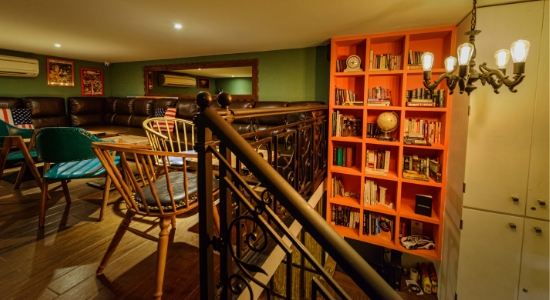
Den and Library at Door No. 1
A combination of vintage wall illustrations, installations and artwork give off the vibe of a journey of exploration. Be it the vibrant crowd-sourced Orange Library, which stores books of various genres, the 3D painted DJ console, which is impossible to miss, or the walls adorned with retro images reminding you of the golden days gone by. Mihir and Vishesh’s personal favourite is the gaming den which stacks up to a PlayStation, neatly packed in a suitcase and a range of childhood board games such as Chess, Monopoly, Pictionary, Scrabble, Sequence.
Spread across an expansive area, Door No. 1 will remind you of the house you so want in Bandra. You enter the living room which has intricate collectables handpicked by the owners and their family. Take a long break and spend the day unwinding at the gaming den, or if you enjoy a faster-paced experience hop over to the bar to groove to some great tunes and enjoy one of their signature cocktails.
An innovative and expansive bar sits at the helm of the restaurant, overlooking the comfortable furniture and seating area, which can accommodate close to a 100 people in totality.
Also Read: Celebrating Turmeric, The Wonder Spice
A Co-Working Space

Door No. 1 is amongst a few places in Mumbai to have a co-working space/community table set-up redefining the way you work. With a dedicated internet line, they will make sure you never miss anything important as the appealing soft tones of retro legends croon in the background. The co-
Best described as wholesome, luxurious with a true passion for retro, Door No. 1 forms an aesthetic balance through experimenting and creating new experiences for patrons.
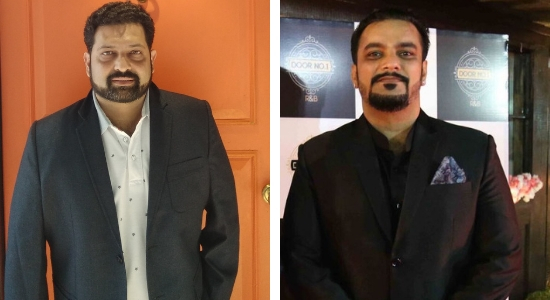
Vishesh Khanna (left) and Mihir Bijur (right)
Speaking exclusively to Restaurant India, the co-founder of Door No. 1, Mihir Bijur says, “the pivot of the restaurant is nostalgia”. Read the full interview:
The Key Accomplishments of Door No. 1 in 2018
2018 has been a great year for us. Along with hosting over 1000 schools, colleges and office reunions, we were also awarded 'Best Retro Bar of Western India' by Restaurant India. Apart from the fact that our events have gotten listed in the Top 5 and Top 10 of the country, we've also been consistently listed in the Top Mumbai Restaurant title by Zomato.
Inspiration Behind the Launch of Door No. 1
Door No.1 is based on a house party because that’s where the idea came from. My business partner, Vishesh Khanna and I would often meet at house parties as no bar played the music we grew up to. At these parties, we realised that even strangers, who entered, connected so well on retro music that they'd end up becoming friends. After the 20th time of joking with each other about starting a bar and taking this nostalgia to connect to the city, we finally quit our corporate jobs one day and chose to follow our passion of building a mecca for nostalgia for an entire generation that has very limited social options in the country.
Must Read: 10-Step Checklist To Open A Bistro In Mumbai
Revenue Model of Door No. 1
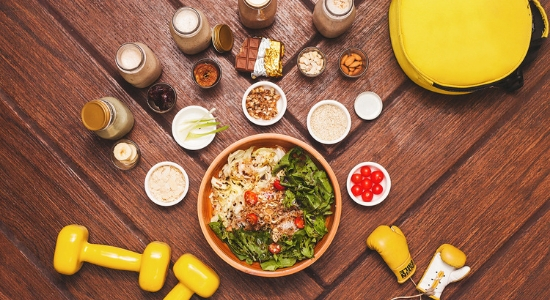
Health Trip Salad
We are a nostalgia place which caters to an entire generation, typically 30-70 years of age who have "been there, done that" in life. This along with retro music from the 50s to the 90s has helped automatically filter our crowd and has introduced us to a lot of CXO regulars and mid-professionals who don't look at the right-hand side column of the menu. Nonetheless, we've not priced ourselves really high and have constantly evolved our menu and pricing to finally set it in the right bracket. We get anywhere between 6,000-8,000 people per month which for a restaurant of our size is a decent number.
Menu and Pricing
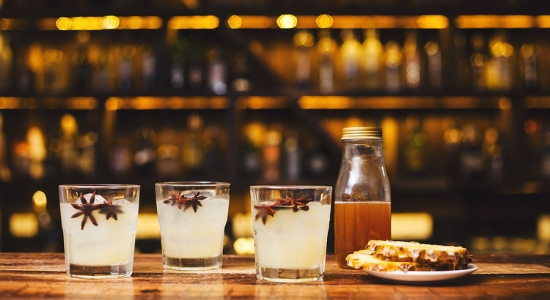
Haw Jack served at Door No. 1
The pivot of Door No.1 is nostalgia. We breathe nostalgia in everything we do - from decor to music to even food. We have a special section called 'Single's Faux Pas' which is all the dishes that we all have cooked up in the kitchen with whatever was available late night when we were studying in school or college. This was an instant hit as it is still our best-selling section. Apart from that, we have evolved both the prices and the dishes overtime after carefully listening to our audience. We've not priced ourselves really high and have constantly evolved our menu and pricing to finally set it in the right bracket.
The elaborate bar menu pays a tribute to retro days and aims to associate with nostalgia. Premium imported spirits and domestic liquor have been used to create a range of cocktails and mocktails. The menu showcases international and local flavours with broad use of fresh fruits, purees and flowers. Some of the noteworthy drinks include Inner Peace a star concoction of Vodka, Cranberry Juice, Grape Juice and Mint syrup, Lemongrass Ginger Martini a delicious blend of Lemongrass, lime juice, vanilla vodka, diced fresh ginger and sliced ginger, Spiked Chocolate Milkshake a potent mix of dark rum, Kahlua, chocolate ice-cream and Texalins, a fusion of white rum, chardonnay, cranberry juice, orange juice and champagne.

Vishesh's Faux Pas
The visual demonstration is a large part of the overall bar experience which encourage interaction and engagement at the bar. For the teetotalers out there, they have ample choices such as Current Affair, Guava Spice, Energy Sunrise and Spice Girl.
Marketing Strategy with Door no. 1
We, at Door No.1, are based around nostalgia as our pivot or essence of existence. Everything we do is based around this feeling, including our marketing. We don't believe in going big with ads and rely on building a big and tight community online which breathes the same passion for our music, vibe, and feel.
Food-tech Companies Help in Brand Building
In today's world of high online visibility, it is impossible to not be on platforms where your audience is. Apart from SEO and SEM purposes, these food-tech companies also help in connecting the user and the brand in a way which 5 out of 10 times results in a footfall. Apart from becoming a one-stop shop for online ordering, they are also amazing shouting boards to keep your audience updated on exactly what to expect when it comes to food, beverage, experience, events and vibe.
What makes a Bar Successful?
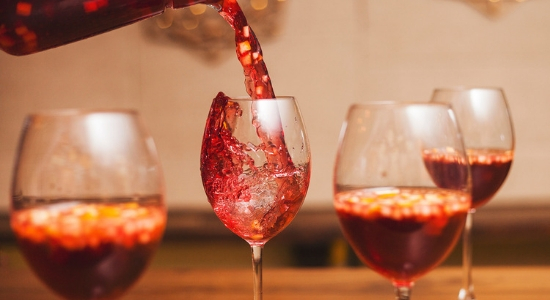
Red Wine Sangria
In the two years of our existence, we've never stopped learning. Each new face and each new day has taught us more about how people think and function. What moves them, what grooves them; we've realised that a bar is successful only if we understand the basic psychology of how humanity functions.
Restaurant Industry Trends in Mumbai
It is encouraging to see more people taking the big move to come out of their comfort zone and start a restaurant. I personally believe this is one of the toughest industries and most under-rated. It is also encouraging to see the audience evolve with socially accepting dining out on a regular basis and going beyond just pricing software and rustic looks. The audience today is very well-informed and knows what they want.

Chef, foodie and businesswoman Pallavi Jayswal is a force to be reckoned with. A culinary wizard, she has achieved multiple feathers in her relatively short career. During these years she has worked with multiple restaurants and brands. Her love for food and entrepreneurship led her to start Uno Más, a Spanish Tapas Bar. She is also the co-founder of Nessun Dorma Food Ventures.
Her first official culinary job was at the mecca of Indian fine dine, Indigo Restaurant at Colaba. She was entrusted to handle an entire section of the kitchen. She reminisces her time there by the fast-paced dinner services and long working hours. She has a Diplôme de Cuisine from Le Cordon Bleu, London and a Level 2 in Wines and Spirits, awarded by the Wine and Spirit Education Trust.
In an interview with Restaurant India, Pallavi Jayswal, Chef and Co-founder, Uno Más - Tapas Bar Kitchen, talks about her journey as a chefpreneur.
“It is an Exciting Time to be in the Food Business”

Interiors of Uno Más - Tapas Bar Kitchen
As compared to the past, consumer culinary trends have progressed by leaps and we are seeing a much evolved Indian clientele that visits our restaurant these days. These guests are well travelled, well-read, curious and extremely aware of food, flavour and overall experience. This is the greatest challenge and compliment as a chef. Having the chance to put out something of your own making, and seeing it, satisfy this refined palate.
The Pros and Cons of Being a Chefpreneur
There are only Pros to being a chefpreneur. It actually simplifies the thought process. There’s never a struggle between innovating in the kitchen and having a guest-friendly offering, tailor-made by your own flavour preferences. Ultimately, it’s the guests’ satisfaction and team's development that’s the broad focus in all decisions. The opportunity to have a voice in the culinary scene, and seek like-minded individuals whose growth I have an opportunity to assist in. The greatest satisfaction is the opportunity to wear both the white cap as well as the corporate suit.
Secret Recipe For Success
Consistency! Delivering new and innovative flavours in an ever-welcoming ambience with an honest warmth in the service of our guests day after day.
Main Challenges While Starting Uno Más
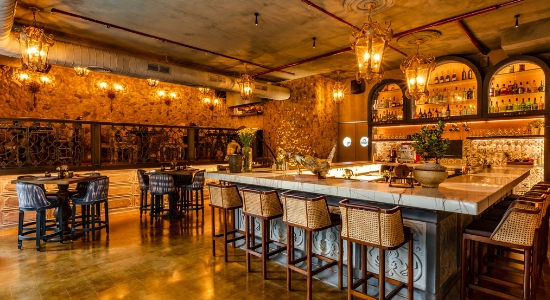
Interiors of Uno Más - Tapas Bar Kitchen
One of the key challenges was choosing our team and being chosen by them. We were extremely particular of whom we wanted to work with and that took substantial time and effort. We persisted but did not compromise even though our selection rate was pretty abysmal. We gave ourselves more time than most to choose and train the best!
Must Read: 15 Inspiring Indian Women in F&B
Key Marketing Strategies with Uno Más
Our priority has always been to provide the overall experience. Food, drink, ambience and guest experience. To say one supersedes the other would be a step in the wrong direction. When you visit Uno Más, our hope is to have you savour every element of the journey that has brought about our offering. Whether it is sipping Sangria at the cantinas of Seville or admiring the bóvedas over the verandahs in Mallorca; the Patatas Bravas on a balcony overlooking the bustle of Madrid or the mystique in the Flamenco in Granada. Our strategy has always been the experience from Hola! to Bienvenidos Amigos to Muchas Gracias.
Also Read: Effective Restaurant Marketing Strategies By Chef Anaida Parvaneh
Catering to Indian Tastebuds
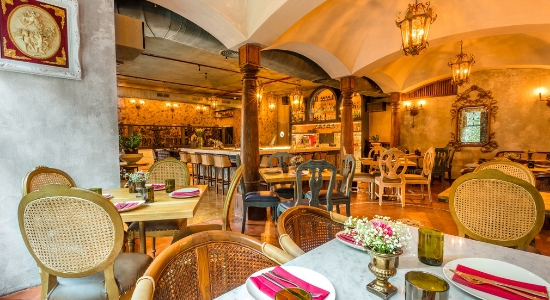
Interiors of Uno Más - Tapas Bar Kitchen
It is a demanding task to present international cuisine with a mild and more subtle flavour profile because as Indians we are used to eating a whole lot of spice. At Uno Más, we’ve paid heed to that and tried to present Spanish cuisine with an Indian heart with the use of subtle, memorable spices without compromising on the Spanish flavours. This has been very well received by our guests. Making vegetables more interesting for Indian guests is always a challenge because most vegetarians, sadly, do not like to experiment with new vegetables.
In Pics: 7 Women Changing Food Service Scene In India
Approach Towards Supply Chain Management at Uno Más
We are very particular about the produce that we bring in to our restaurant which means the best of Spain and Europe (Olives, Olive oil, Cured meats, cheese etc.) to the best of sustainable local produce. We have partnered with trusted importers, artisanal confectioners, responsible growers and process driven suppliers to bring a high-quality offering to the table.
Food and Drinks People Order More at the Restaurant
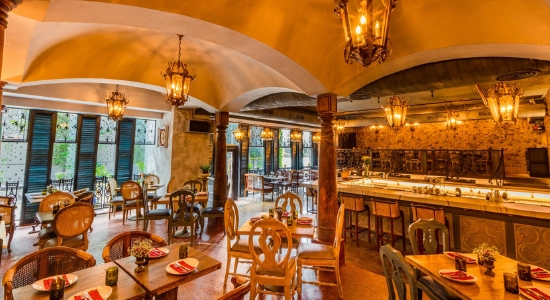
Interiors of Uno Más - Tapas Bar Kitchen
We are so pleased to have seemingly been able to imbibe the heart of India with the soul of Spain. While our signature tapas like the Gambas Al Ajillo (Garlic prawns cooked in prawn head oil) and the Patatas Bravas (Crispy baby potatoes in smoked salsa brava with garlic aioli) are definitely amongst the most coveted finger foods on offer, the Sunday Roast (Black spiced whole roast chicken) seems the likely choice for brunch with friends and family over the weekend. The Shroom, and The Frenchie, certainly seem to leave our guests calling for Uno Más where the tipple is the name of the game. For desserts, it's Churros for the win by far.
These, mainly because the Paella de Marisco or Sangria Tinto might just sound overly generic for a Spanish restaurant in BKC, right?
Presence, Growth and Expansion Plans
At Nessun Dorma, we are all about the unpretentious, wholesome dining experience that has the ability to transport you to our travels around the globe. The response to our first venture has been overwhelming and this is definitely the inspiration for more to come. Uno Más we say!

In a tête-à-tête with Restaurant India, Shivam Sehgal, founder of The Market Place restaurant, shares his secret on how he is planning to go big with his restaurant.
How do you come up with the concept of your restaurant?
I started with the basic concept of the restaurant as a whole and then narrowed it down to a buffet restaurant. I never wanted a regular buffet kind of restaurant. To get over and bring something new to the market, I, with my team, thought of coming out with the idea of the live kitchen, mini-restaurants inside one big restaurant, similar to a food court concept, and then it should have global cuisines on the menu.
At The Market Place, we cater to people of all age groups – from a child to the eldest member of the family.
Selecting the Location
The Market Place at Kirti Nagar in Delhi is the pilot project. We opened at Kirti Nagar to see who wins, whether it’s the concept or the location. And the concept won! People like the concept more. I wanted to see how much potential this project has. It’s all about the food and the concept.
Read Review: This Unique Concept Restaurant Is Creating A Big Buzz In Delhi
Out of 100 customers visiting the restaurant, I make sure to meet at least 90. It’s my motive that my guests leave the restaurant with a smile on their face. If anything is bugging them, I am there to solve it out. It about a personal connection with them, taking reviews and feedback. Fortunately, we are getting 99% positive reviews.
How did you come up with the menu of The Market Place restaurant?
The Consultant Company, Secret Ingredients had helped us in creating the menu and the system of the restaurant. The founder of Secret Ingredient, Sid Mathur is also a cuisine creator at Impressario.
Some of the interesting findings you came across while you were doing the R&D for your business?
All the places we went around for buffet during the R&D, I noticed one thing that was very certain with the diners. If four people are sitting at a table, one of them, at least, ends up saying “I want to have burgers here” or “I want to have Shawarma” or I want to have dim sum”. So, that was the question that hit me straight away, that if they aren’t getting what they want, it is quite possible that the particular diner won’t come back again. One of them would cut it off. At that time, I decided to bring on the maximum things on the table, giving choice to people.
What are the pros and cons of being a partner at any restaurant?
I ventured with Varun Puri for Too Indian and Duty Free. I was always there as a manager who would learn things at the restaurant, to make a passion out of business.
There are almost no cons if you are in the right partnership. I have seen none of them. My partner is a very nice leader; I got to learn many things from him. I would suggest - don’t force yourself to be in partnership with the person you do not like or who might not go along with you. Just work with the person and know him inside out. See how they work. It’s the passion you should see in someone’s eyes. And how willing he is to work and teach their staff around.
What are your growth and expansion plans for The Market Place?
We will be soon expanding with three more outlets in Delhi-NCR – Dwarka, Noida and Gurugram. Dwarka is still untapped; it doesn’t have many good restaurants that would cater to the mass audience living in the area.

Though, Maharashtrian cuisine is known for its distinctive attributes, but its shares a lot with the wider Indian cuisine. There are many diners who appreciate the raw traditional food because of its unique taste and presentation. With a vision of offering the traditional Marathi cuisines to the diners, Yogesh Magar conceptualised Wah Marathi.
In conversation with Restaurant India, Yogesh Magar, Director, Wah Marathi, discusses about challenges and responses for the brand.
Talk to us about Wah Marathi and the journey so far?
It all started with offering authentic Maharashtrian food to the guests blended with contemporary ambiance with stellar customer service. This was aimed at appealing not only the indigenous people, but non-natives as well. The notion of proposing native dishes to Maharashtrian community was a big task. We wanted to break away the conventional way of serving Thalis and present the same in a fine dining format. I had always felt the vacuum for eateries. Food being my passion and a core Maharashtrian by birth, I wanted to offer pure and fresh food to the masses, belonging to our own culture away from the rush of fast-foods.
Maharastrian food is so diverse and, much of it remains unexplored. People need to know that Maharashtrian food is beyond vadapaav. We conducted extensive research by visiting distant villages of Maharahstra to explore new dishes and recipes. Our team members learnt so many traditional recipes from elderly people, which has actually added a flavour to our menu and helped us in creating unique flavours.
We believe that learning is constant and we continuously strive to evolve our offerings on the table.
Share with us the initial challenges you faced while rooting the business into the market?
The Menu: Designing the menu was the most challenging part. We experimented almost 400 dishes, and it took us at least 4 months to filter them. The challenges were — reducing operational cost, offering better prices and maintaining authentic flavours. All this was to be catered without compromising on quality.
Manpower: While exploring the regional cuisine, the major challenge remains in getting the right manpower. The staff involved in preparation of regional cuisine needs to relate with the offering. We struck the ball right on this, to hit a home run.
Acceptance: Pune is a choppy market. One needs to do thorough research before putting anything on the platter. Offering Marathi food to the locals in fine dining concept was indeed an uphill task, but we succeeded eventually.
Unique Selling Point: Offering Maharashtrian food on à la carte, a model, which was well received by our patrons.
Marketing; Established in the vicinity of one of the biggest IT hubs, Magarpatta Cyber City, Pune, the challenge was to attract not only the locals, but at the same time, the non-Maharashtrians as well, who resided in and around the IT city.
How has been the consumer response so far?
The response has been overwhelming so far, and our fan following has been increasing by the day. People sometimes get nostalgic about the whole experience. They relate it to the home-cooked foods by their mothers and grandmothers. Apart from our guests we have been getting requests to set up more of these restaurants in other cities and abroad as well.
The industry has seen a growing interest from private equity to venture capital investors. How do you see the trend in the years to come?
Being in the food and restaurant industry for the last 13 years, we have seen trends changing over the period of time. We have seen a lot of new entrants, including MNC’s venturing into this business. This is a welcoming change, and this affirms that the market has huge potential with several areas to be explored. Restaurant & food industry is a game of patience and persistence. One has to believe in his offering to be able to convince the masses.
How do you plan to compete with the new-age food chains and licensed stand alone players?
It may sound hard to believe, we do not consider us as a part of the rat race. One has to stand out from the crowd and work hard to remain in the completion and to carve a slice out of this large pie. To hit the box office a movie should have a very strong content, story line and dedicated actors. We, at Magarpatta clubs & resorts, follow the same path to make our brand ‘Wah Marathi’ a great success.
What according to you are 4 important growth drivers in this industry?
The most important growth drivers in the industry are:
1. Internationalisation / globalisation.
2. Integration opportunities.
3. Innovation
4. Manpower
How has been the response towards other assets of Magar Hospitality?
Response to all our assets including Hotel Cocoon- 118 keys all suite hotel, Deccan Harvest: 230 covers, Multi cuisine fining dining restaurant & Lounge and Mega Meals: corporate catering unit with a capacity of producing thirty thousand meals in a day, has been overwhelming. All these brands have evolved over the period of time and have been contributing significantly towards the total earnings of the company.
How has technology helped you pivot your business in the right direction?
We strongly believe that technology in F & B industry will play a major role towards a better future of our businesses. We have been a technology driven company equipped with strong ERP systems for our back office, material management and front of the house operations. Technology will play a key role for better future prediction as the data gathered over the period of last 10 years will lay the foundation stone of a rewarding future.
Where do you see the future of the industry 3-5 years down the line?
We are very optimistic about the future and wish to play our part in the overall growth and sustenance.
Share with us your future expansion plans? How much revenue do you expect by the end of FY16?
Enriched with rich industry experience of more than a decade, Wah Marathi has become a tried and tested brand within a short span of three years. Besides developing our reach in other parts of the country, we have plans to expand within Maharashtra as well. Our kitty will include the Franchised as well as company-owned outlets. As mentioned earlier, we have been getting enquires for franchise models, but will be working cautiously to make every unit, be it franchised or otherwise, a sustainable and successful model.

"Being a chef is all about creating moments of joy for someone else. You get joy out of others savouring of your creations."
~Chef Nilesh Limaye.
Chef Nilesh Arun Limaye is on culinary voyage since 1995. His career has spanned senior positions at leading hotels across India that includes The Taj Mahal Palace, Mumbai. He was also a part of MasterChef India Season 5 creatives team.
Popular as Sindbad the Chef, Nilesh Limaye has travelled across the globe working for the best in the industry. It was in 1992 that he realized he wanted to be a professional chef. “The kitchen is the heart of the hotel, I realized this quite early, during my training period i.e. 1992, at the Taj President. The scenario was very different then. Taj and Oberoi were some of the hotels that were popular then. You get to see the best at these hotels,” says Chef Limaye.
It was at a Hyderabadi Food Festival, organized at the Taj, Chef Nilesh Limaye realized that he will take the career forward. “It was the moment where you understand this is what you want to go forward with,” he adds. Chef Nilesh Limaye was one of the guys who donned chef’s hat pretty early, six months before completing his graduation.
“I cultured like music – classical and remix. I loved the classical side of cooking food - no jhatka, no cowboy method. I learnt the correct methods, how to measure the ingredients; I learnt the real way of cooking food.”
After working with Taj for five years, Chef Nilesh, in order to get more experience in the food and beverage industry, joined Chef Sanjay Malkani. With Chef Malkani, he learnt the planning of a restaurant setup, kitchen and menu designing. "That’s where my actual experience started building up,” recalls Chef Limaye. It was a small stint on a ship that gave him exposure to the food culture of various regions of the European continent. "Till the time you don’t go out and visit the places, you don’t understand the importance of the local tastes and flavours.”
In 2009, Chef Limaye came up with his own venture All Bout Cooking. Though there were many restaurants opening up in India, people lacked knowledge in the kitchen and planning. "I understood the need. And, therefore, I decided to go with All Bout Cooking to give restaurants an understanding on the Indian requirements, how they should plan and design the concepts, menu and the food service etiquettes,” says Chef Limaye.
In an exclusive talk with Restaurant India, Chef Nilesh Limaye speaks about the importance of regional cuisines at restaurants in India and his ideas behind menu planning and kitchen designing.
The Real Treasure Lies in Regional Cuisines
You always get the real taste at a smaller local restaurant, the places which are not much into advertising. When I went to Kolhapur, I tried mutton lonche, I was astonished. In Kolhapur they have done PhD in mutton dishes, I must say. But such regional cuisines don’t get much recognition. I am inclined towards spreading awareness of the variety and the usage of regional food.
I was, recently, the host at Cordon Noir 30th anniversary celebrations. Cordon Noir is the Gourmet club founded by Jochen Kern. The idea was to bring together the people who love food; the standard is maintained through caviar, which is considered as the topmost delicacy. We explore the culture and cuisines of new places every year. This time it was done in Mumbai as I wanted to show the chefs and food lovers the local Maharashtrian cultures and food.
Farm to Food Concept
The farm to food has always been our concept. People would use sun-drying or pickling methods to store food. Our culture was always seasonal food where people would grow rice, make curries with fresh fishes. There is a group of nature lovers who would grow food on their terraces like spinach, pumpkin, chillies, lemons. I personally feel the local markets should be there; that cycle should not be spoilt with the bigger grocery brands.
Learn the Classical Way of Cooking
Regional cuisines are the basis of Indian food. If you visit Kolkata house or Andhra house, they do not add the ‘cashew nut paste' in the curries. The strength of India lies in the classical way of cooking and serving local cuisines. We need to build our food on that basis.
Today, if the chefs actually learn their own traditional food, they will be able to create more ideas. The real recipes lie in, say, Goan fish curry or the Saraswat fish curry; we don't know the food of our origin or region. The information is available, not on search engines, but in the regions themselves. One needs to go and find them out.
Advice to Chefs
"When it comes to fusion food, most of the people, right now, are doing the stupid things."
My suggestion to the chefs will be to just learn ten authentic dishes. Once you learn the classical side of it, I think, creating derivatives is not a problem. Adding oregano in a modak, someone would call it creative but I would call it a stupid idea. Fusion and modernity have to happen but till the time you don't learn to make a fundamental modak from the recipe, you cannot make a variable.
Even you can create dal vada into pop-corn style!
At Bindas Begum, we had a Bhavnagri Mirchi recipe which was served with feta cheese. I thought it was our dish, but on my visit to Bhutan, I found the same chilli is served with a cheese sauce; this was a 100-year-old recipe. I was zapped how this amalgamation occurred! Feta cheese, 100 years back! So, people knew about it.
Also Read: Four Essential Design Elements For Casual Dining Restaurants
A Restaurant will Collapse if…
The restaurant people see food, but to create dishes, one has to have a proper structure and a well-planned design. If a restaurateur fails to understand the menu planning, kitchen designing and meals preparation, their restaurant business will straightaway collapse. All these things are interconnected.
We design the kitchen depending on the menu. The kitchen is decided depending on the concept of the restaurant. According to the concept we make the menu. Once the menu is made we do the kitchen design. If the work is evenly distributed for a proper area of storage and working, then everything becomes smooth. Cooking food is not a big part but having a right balance of organizing everything is very important.
In our kitchen pre-preparation is always important.
Must Read: People Choose Home Over Restaurants To Drink Scotch. Know Why?
Back-to-Basic Technique Will Help Restaurants Grow
I had seen the restaurants serving the classical dishes in my early career as a chef, and then fusion and modern foods were introduced following which came the molecular concept. Now, people are back to the basic cuisines. If you see people from across the globe are cooking good and right jus, gravy with brown sauce. After the jus is created rightly, the people give it some kind of formation. Maybe, they will try it in a dehydrated form or put it into a liquid nitrogen giving a different texture. The technique more or less has been the basic of cooking which is baking, broiling, roasting, grilling and steaming.
Dehydrating is a part of roasting. Earlier we were dehydrating at a very high temperature but now we are doing it at a very low temperature for a longer period.
While speaking about India, I feel that people are working on a few main parts like tandoor and barbeque. Nowadays people are also trying to source the ingredients which are exotic. They are trying to source out a specific ingredient say Himalayan rock salt or a particular chilli.
While making desserts like macarons, the basic technique is also important. We create different kinds of macarons by adding cream or by whipping the cream or by using the aquafaba for vegans.
Getting the right temperature and knowing how many seconds will it take to get the right texture is important. The detailing has increased in getting the right flavour.
At the crux of it, basic technique matters.
Copyright © 2009 - 2025 Restaurant India.





